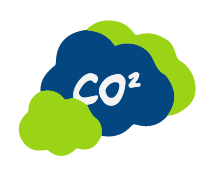
We have developed a life cycle analysis calculator tool for screening various packaging materials so that the environmental impact of a product throughout its life cycle can be approximated, thus comparing the performance of different materials and processes.
- Does not include field activities or laboratory analysis
- Does not include critical review or corrections of critical review.
WHAT FACTORS DO WE MEASURE?

Carbon Footprint
Amount of greenhouse gases (GHG) emitted throughout the life cycle of a packaging, measured in tons or kilograms of carbon dioxide equivalent (CO2e). It measures the global warming potential generated by a product throughout its life cycle.

Energy Demand
Amount of energy (direct or indirect) consumed in the making of the product. This measure is expressed as an energy unit (KJ).

Water Usage
Amount of water involved in the life cycle of the product (from its manufacture to its recycling or reuse). Measured in liters (L). This metric excludes water used in cooling processes or in the use of hydroelectric plants.

ReCiPe (end point)
The ReCiPe methodology unifies and weighs the impact on ecosystems, human health, and resource depletion into a single indicator, with the goal of comparing differences between products. Its unit of measure is millipoints (mPT), where one point (Pt) equals one-hundredth of the annual environmental burden of an average European citizen, meaning an average European citizen generates 100 Pt of environmental burden per year.

Solid Waste Generation
Amount of waste that is generated throughout the life cycle of the product, considering both post-industrial waste incurred in production processes and post-consumer waste once the packaging is used.
Plastic Waste Generation
Amount of plastic waste that is generated throughout the life cycle of the product, considering both post-industrial waste incurred in production processes and post-consumer waste once the packaging is used.

We have compared the impact of different types of products during their life cycle so you can consider this when consciously choosing a packaging.
The traffic light concept applied to the environmental impact of products provides a simple and visual classification:
green color symbolizes those products that lead in terms of positive performance in a specific impact category, while red indicates the products with the worst performance in the same category.
However, it is crucial to understand that this color coding does not necessarily imply that the impact is high or low in absolute terms but serves as a comparative tool between different materials within various impact categories.


| Cups | Carbon footprint (g CO2e) | Energy demand (kJ) | Water usage (L) | ReCiPe (mPt) | Solid waste generation (kg) | Plastic waste generation (kg) |
|---|---|---|---|---|---|---|
Wood Pulp paper cup | 80 | 88 | 0 | 60 | 0 | 100 |
Sugarcane bagasse cup | 100 | 100 | 24 | 96 | 7 | 98 |
PET cup | 0 | 0 | 71 | 0 | 10 | 0 |
RPET cup | 62 | 98 | 91 | 57 | 10 | 0 |
PP cup | 86 | 66 | 95 | 80 | 81 | 59 |
PS cup | 10 | 11 | 85 | 48 | 29 | 16 |
EPS Foam cup | 92 | 85 | 100 | 100 | 100 | 75 |

| Bandejas | Carbon footprint (g CO2e) | Energy demand (kJ) | Water usage (L) | ReCiPe (mPt) | Solid waste generation (kg) | Plastic waste generation (kg) |
|---|---|---|---|---|---|---|
Wood Pulp paper tray | 66 | 81 | 0 | 38 | 0 | 100 |
Sugarcane bagasse tray | 98 | 100 | 22 | 89 | 6 | 100 |
EPS Foam tray  | 100 | 90 | 100 | 100 | 100 | 75 |
PET tray  | 0 | 0 | 77 | 0 | 39 | 0 |
rPET tray  | 64 | 98 | 91 | 55 | 39 | 0 |

| Containers | Carbon footprint (g CO2e) | Energy demand (kJ) | Water usage (L) | ReCiPe (mPt) | Solid waste generation (kg) | Plastic waste generation (kg) |
|---|---|---|---|---|---|---|
Wood Pulp paper container  | 34 | 79 | 0 | 0 | 0 | 100 |
Sugarcane bagasse container | 100 | 100 | 22 | 83 | 5 | 99 |
EPS Foam container | 96 | 83 | 100 | 100 | 100 | 69 |
PP container | 0 | 0 | 93 | 10 | 42 | 0 |
